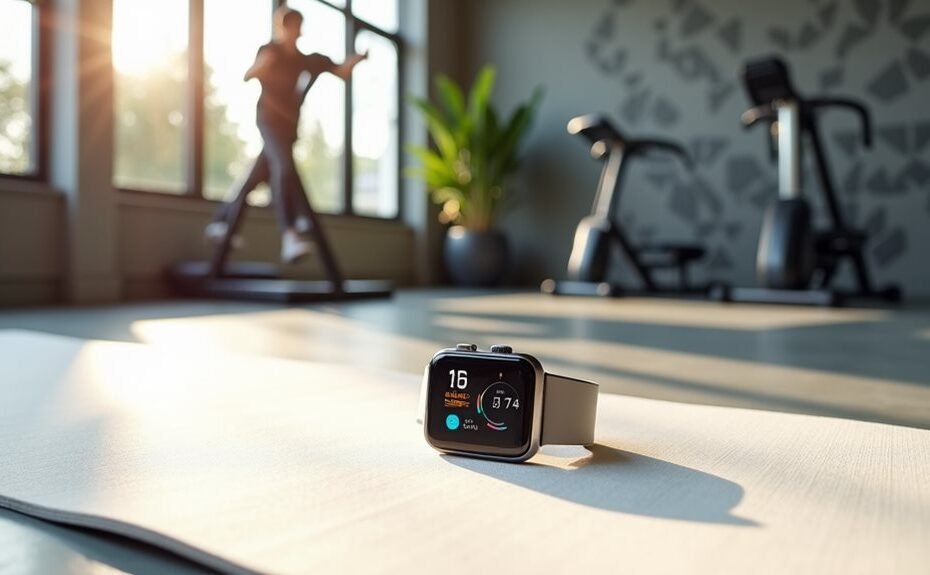Just last week, as I was organizing my old gym bag, I found my first workout journal from five years ago, reminding me how essential tracking progress was to my fitness success. I've learned that many beginners skip this fundamental step, thinking it's unnecessary or too complicated, but I can't emphasize enough how this simple habit transforms vague hopes into measurable achievements. Whether you're lifting weights, running miles, or changing your diet, there's a practical way to document your journey that'll keep you focused and motivated – and I'll show you exactly how to start.
Some of the links in this article may be affiliate links. If you make a purchase through these links, we may earn a small commission at no extra cost to you. Thank you.
Key Takeaways
- Start with a basic notebook to record exercises, sets, reps, and weights used during each workout session.
- Take consistent progress photos every 4-6 weeks using the same lighting, angles, and form-fitting clothes.
- Record body measurements monthly, focusing on key areas like chest, waist, hips, arms, and thighs.
- Set clear, achievable weekly goals and track them alongside post-workout notes about energy levels and performance.
- Use free fitness apps to log workouts, monitor nutrition, and track basic health metrics like weight and heart rate.
Why Track Your Progress
When you're starting your fitness journey, tracking progress might seem like an unnecessary extra step, but it's actually one of the most powerful tools you'll have. I can't stress enough how critical it's to document your journey – it's like having a GPS for your fitness goals.
Let me break this down for you.
First, tracking gives you cold, hard evidence of improvement. When you're feeling stuck, I'll bet you'll find proof of progress in your logs that you didn't even notice. Plus, there's nothing quite like flipping back through your training journal and seeing how far you've come – trust me, it's a massive motivation boost. Regular maintenance of your tracking system ensures your progress monitoring remains accurate and helpful. Setting up a consistent monitoring routine will help ensure you stay on track. Early detection of issues helps you address problems before they derail your progress.
You'll also develop an uncanny ability to spot patterns. Feeling weak on Mondays? Your tracker will show you why. Think you're consistent with workouts? Your log will tell you the truth, no sugar coating. And when you hit those inevitable plateaus (we all do), you'll have the data to make smart adjustments instead of random guesses.
It's simple: those who track, progress. Those who don't, wonder why they're stuck.
Getting Started With a Notebook
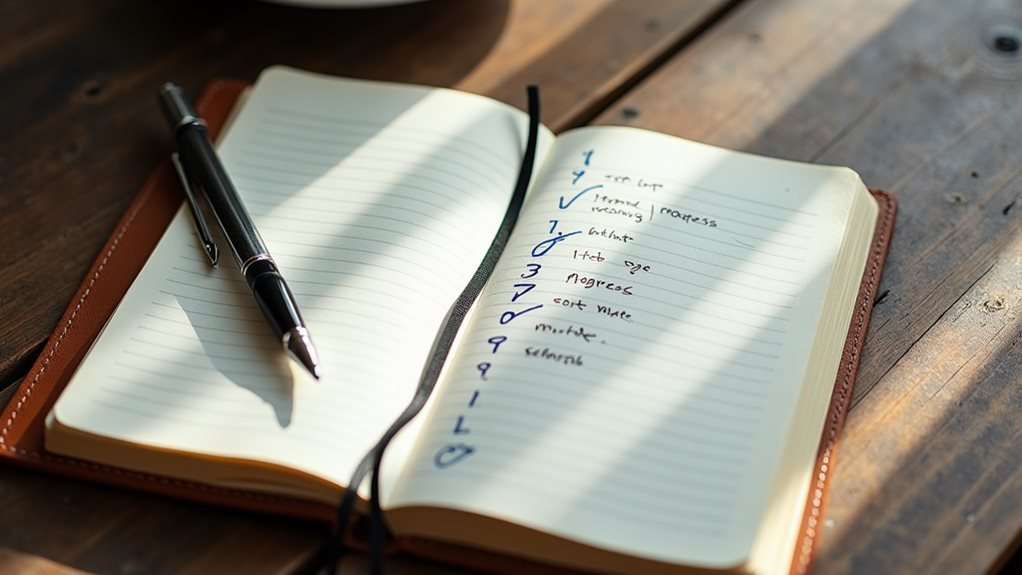
In the world of fitness tracking, a simple notebook is your most powerful ally. Let's get you set up with a system that'll actually work – no fancy apps required, just pure progress-tracking efficiency.
First, grab a notebook you'll actually use. I'm talking about something that fits in your gym bag, not some leather-bound tome you're afraid to get sweaty. Create a template that tracks the essentials: exercises, sets, reps, weights, and how you're feeling. Don't overcomplicate it. Breaking tasks into smaller pieces helps maintain clear progress visibility.
Here's the non-negotiable part: you must write in it every single workout. No exceptions. Break down your goals into weekly targets – something like "add 5 pounds to squat" or "complete all planned sessions." Trust me, these small wins compound faster than you'd think. Task management software can help, but starting with pen and paper builds better habits. Strengthening lower body muscles can be effectively tracked by monitoring your progress in leg exercises.
Set aside five minutes post-workout to record everything while it's fresh. Include notes about form, energy levels, or that weird twinge in your shoulder. This isn't just data collection; it's your roadmap to improvement.
When you're three months in and wondering if you're making progress, this notebook will be your reality check.
Digital Tools and Apps
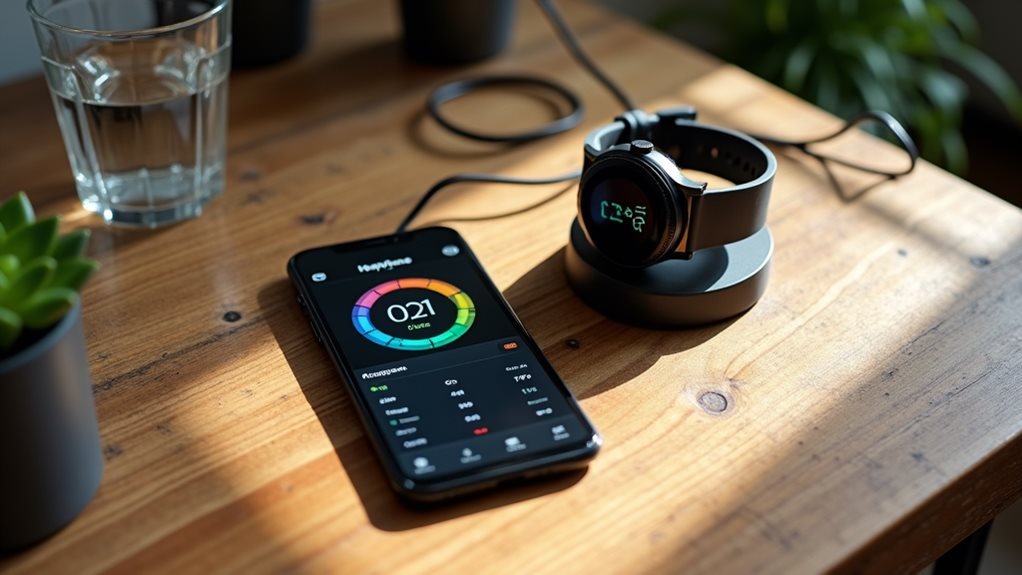
While paper notebooks offer reliability, modern technology provides powerful alternatives for tracking your fitness journey. I've found digital tools excel at automating the tedious parts of progress tracking, letting you focus on what matters – the actual work. The growing market for home fitness equipment suggests digital tracking aligns perfectly with modern exercise trends.
- Start with a dedicated goal-tracking app like Strides or Way of Life – they're designed specifically for habit formation and won't overwhelm you with unnecessary features. Many apps like Coach.me offer support communities to keep you motivated.
- Add time tracking through Toggl Track or RescueTime to understand where your workout minutes actually go (trust me, you'll be surprised)
- Level up with project management tools like ClickUp or Notion once you're ready to plan complex workout programs
Look, I'll shoot straight – don't get caught in app paralysis. Pick one tool and master it. Habitify's perfect if you want cross-platform support with health app integration. Need more structure? GoalsOnTrack helps break down those ambitious fitness goals into manageable chunks. Can't stay focused? Tide's got your back with built-in timers and breathing guides. The key isn't which app you choose – it's sticking with it long enough to see results. With smart bike technologies emerging, tracking your progress has never been more engaging and interactive.
Taking Effective Progress Photos
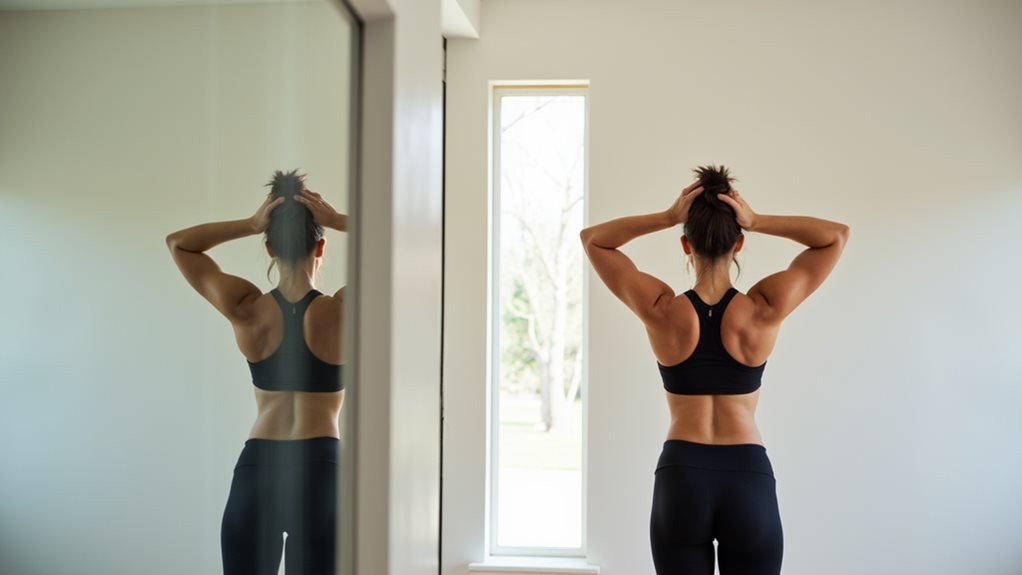
Progress photos serve as your visual roadmap to fitness success, documenting changes that daily mirror checks might miss. I'll tell you exactly how to nail these shots every time.
First, lock in a specific day and time – preferably morning, before eating. Taking photos on an empty stomach helps eliminate water retention variables. Stick to it religiously, whether you're shooting weekly or monthly.
Your setup matters more than you think. Find a spot with consistent lighting – natural light works best – and a clean, plain background. No messy rooms or distracting patterns allowed. Taking photos near a window provides optimal illumination. Position your camera at chest height on a tripod or stable surface. Trust me, bathroom selfies won't cut it.
Wear form-fitting clothes that show your physique clearly. I'm talking shorts or underwear for guys, sports bra and shorts for women. Don't get creative here – use the same outfit every time.
Hit three essential angles: front, side, and back. Stand straight, feet hip-width apart, arms relaxed. And please, no flexing or fancy poses – we're documenting progress, not auditioning for a fitness magazine. Keep it simple, consistent, and clinical. That's how you'll see real changes over time.
Measuring Your Body Changes
Body measurements tell a deeper story than the scale ever could. I'm going to show you exactly how to track your progress beyond those frustrating numbers staring back at you each morning. Trust me – your body's changing in ways that weight alone can't capture. Taking measurements at the same time each week ensures consistent tracking.
- Take measurements first thing in the morning, before breakfast. Your body's most consistent then, and you'll get the most accurate results. Men and women both need to focus on five key areas when measuring progress.
- Use these key measurement spots: biceps at peak, chest at nipple line, waist at belly button, hips at widest point, and thighs at midpoint.
- Double-check every measurement twice – average those numbers for precision you can trust.
Don't skip the documentation part. I want you marking down those numbers weekly, same time, same spots. Use physical landmarks like freckles or specific bones to nail your measurement points consistently.
And here's the kicker – combine these measurements with progress photos and body composition analysis. You'll build a complete picture of your transformation that'll keep you motivated when the scale throws a tantrum. Remember: muscle gains mightn't budge that scale, but your measurements won't lie.
Recording Your Daily Workouts
Starting your fitness journey without proper workout tracking is like driving without a map – you might move forward, but you won't know if you're heading in the right direction. Let's fix that right now. I'm going to show you exactly how to track your workouts like a pro.
First, grab either a notebook or download a fitness app – I recommend FitNotes or Strongly for beginners. For each workout, you'll record four essential elements: exercise name, weight used, number of reps, and sets completed. Don't skip logging how you feel after each session – it's invaluable data for future reference.
Here's the non-negotiable part: track every single workout. No exceptions. Use a simple list format if you're going analog, or let your chosen app do the heavy lifting.
Want to level up? Add time stamps and heart rate data using a fitness tracker. Trust me, you'll thank yourself in three months when you can prove that your bench press has increased by 30 pounds or your mile time has dropped by two minutes. Remember: what gets measured gets improved.
Setting Realistic Milestones
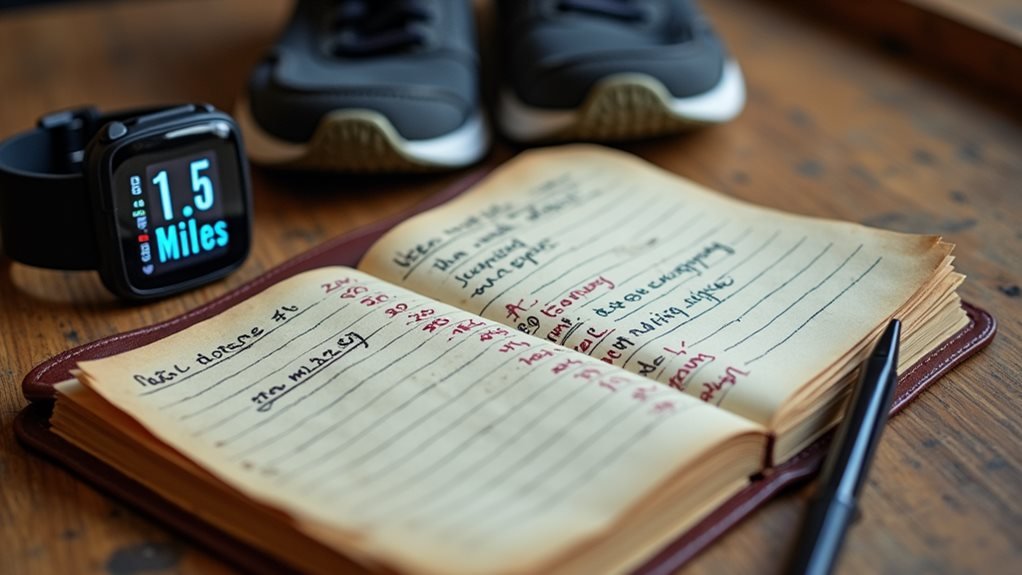
Along with tracking your workouts, you'll need clear milestones to measure your fitness progress effectively. I'll show you how to set achievable goals that'll keep you motivated without burning out. Let's break down your fitness journey into manageable chunks that make sense for your current level.
- Start with bite-sized weekly goals – I'm talking specific targets like "complete three 20-minute workouts" rather than vague promises like "exercise more"
- Set monthly benchmarks that build on each other – if you're doing 5 pushups now, aim for 8 next month, not 50
- Create quarterly milestones that reflect significant progress – think "run a 5K" or "deadlift my bodyweight," not "get shredded"
I'll be straight with you – your milestones need to follow the SMART framework. Make them specific, measurable, achievable, relevant, and time-bound. Don't fall into the trap of setting unrealistic goals – that's a fast track to frustration. Instead, focus on progressive improvements that you can actually track and celebrate. Remember, I want you monitoring these milestones regularly and adjusting them when needed.
Reviewing Your Training Data
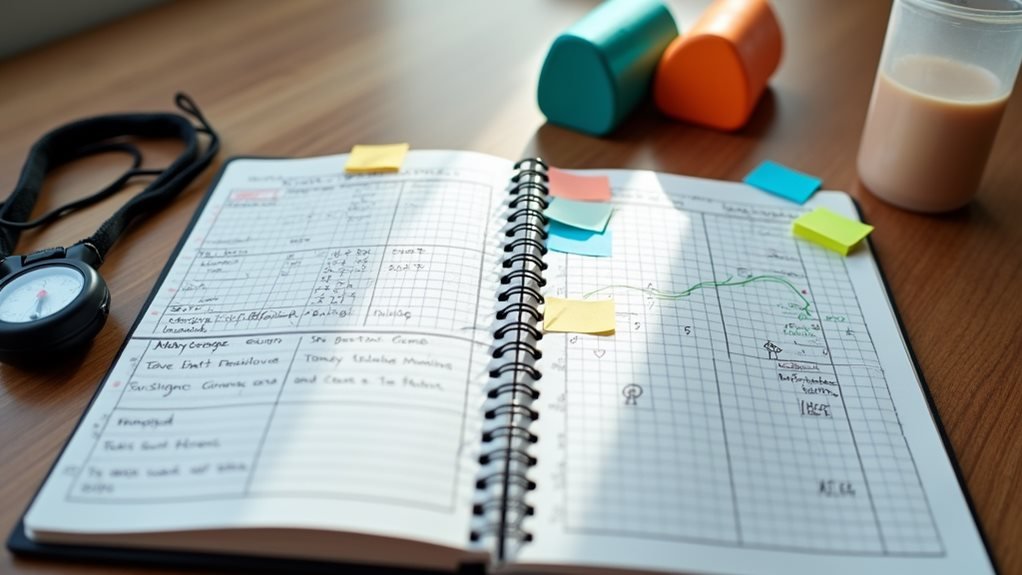
Now that you've established your milestones, let's focus on how to analyze your workout data effectively. I'll show you exactly how to make sense of those numbers you've been recording.
Start by reviewing your workout logs weekly – trust me, patterns emerge faster than you'd think. Look for increases in weight, reps, or total volume load. These aren't just numbers; they're proof of your progress.
I want you to pay special attention to your Rate of Perceived Exertion (RPE) scores. If you're consistently rating workouts as too easy (low RPE), it's time to bump up the intensity. If everything's a 10/10, you're probably pushing too hard. Your sweet spot is usually between 7-8 RPE for most working sets.
Don't forget those progress photos – they'll tell you things your numbers can't. Compare them side by side every 4-6 weeks. Notice how your form has improved? How about those subtle changes in muscle definition? That's your data telling a story. Make adjustments based on what you see and measure. Remember: if you can't measure it, you can't improve it.
Breaking Through Performance Plateaus
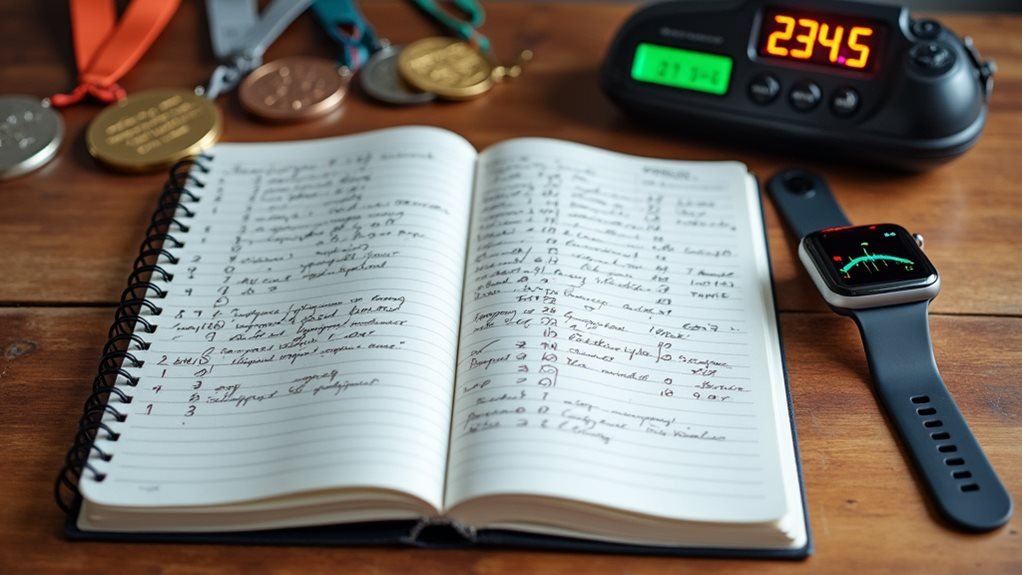
- Switch up your routine every 4-6 weeks – same exercises get boring, and your body gets lazy
- Track your nutrition like a scientist – plateaus often stem from eating the same old stuff
- Rest harder than you train – recovery isn't optional, it's where the magic happens
I'm going to be brutally honest: breaking through plateaus requires both physical and mental toughness. You'll need to shake things up, challenge yourself with new training methods, and maybe even step outside your comfort zone.
Cross-training, HIIT workouts, or completely different exercise modalities might be your ticket out. Remember, plateaus are temporary – they're not stop signs, they're just speed bumps on your path to progress.
Frequently Asked Questions
How Often Should I Update My Workout Log During a Training Session?
I recommend updating your workout log immediately after each set, tracking weights, reps, and rest periods. It's easier to maintain accuracy when you log everything in real-time.
Can I Track Progress Effectively Without Using Progress Photos?
I'd recommend using body measurements, workout logs, and energy level tracking as effective alternatives to progress photos. You'll still get reliable data about your fitness journey's success.
Should I Record Failed Attempts and Incomplete Workouts?
Like breadcrumbs on a trail, I strongly encourage you to record failed attempts and incomplete workouts. They're valuable data points that'll help me guide your progress and prevent future setbacks.
When Is the Best Time to Take Body Measurements?
I recommend taking your measurements in the morning before breakfast, wearing minimal clothing, and sticking to the same day each week for consistent, reliable tracking of your progress.
How Do I Know Which Metrics Are Most Relevant for My Goals?
I recommend aligning your metrics with specific, measurable goals. I'll track what directly impacts my objectives, like weight for fat loss or strength gains for muscle building.
